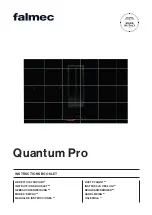
en
Avoiding material damage
4
▶
Do not install the appliance near a solid
fuel heating appliance (e.g. wood- or coal-
burning) unless the heating appliance has
a sealed, non-removable cover. There must
be no flying sparks.
WARNING ‒ Risk of burns!
The appliance and its parts that can be
touched become hot during use, particularly
the hob surround, if fitted.
▶
Caution should be exercised here in order
to avoid touching heating elements.
▶
Young children under 8 years of age must
be kept away from the appliance.
Hob protective grilles may cause accidents.
▶
Never use hob protective grilles.
Metal objects on the hob quickly become very
hot.
▶
Never place metal objects (such as knives,
forks, spoons and lids) on the hob.
The appliance becomes hot during operation.
▶
Allow the appliance to cool down before
cleaning.
▶
If hot liquids penetrate the appliance, only
remove the grease filter or the overflow
container once the appliance has cooled
down.
WARNING ‒ Risk of electric shock!
Improper repairs are dangerous.
▶
Repairs to the appliance should only be
carried out by trained specialist staff.
▶
Only use genuine spare parts when repair-
ing the appliance.
▶
If the power cord or the appliance power
cable of this appliance is damaged, it must
be replaced with a special power cord or
special appliance power cable, which is
available from the manufacturer or its Cus-
tomer Service.
If the appliance or the power cord is dam-
aged, this is dangerous.
▶
Never operate a damaged appliance.
▶
Never operate an appliance with a cracked
or fractured surface.
▶
Never pull on the power cord to unplug the
appliance. Always unplug the appliance at
the mains.
▶
If the appliance or the power cable is dam-
aged, immediately switch off the fuse in the
fuse box.
▶
An ingress of moisture can cause an electric
shock.
▶
Do not use steam- or high-pressure clean-
ers to clean the appliance.
The insulation on cables of electrical appli-
ances may melt if it touches hot parts of the
appliance.
▶
Never bring electrical appliance cables into
contact with hot parts of the appliance.
WARNING ‒ Risk of injury!
Saucepans may suddenly jump due to liquid
between the saucepan base and the hotplate.
▶
Always keep hotplates and saucepan
bases dry.
▶
Never use icy-cold cookware that has been
in the freezer.
When cooking in a bain marie, the hob and
cooking container could shatter due to over-
heating.
▶
The cooking container in the bain marie
must not directly touch the bottom of the
water-filled pot.
▶
Only use heat-resistant cookware.
An appliance with a cracked or broken sur-
face can cause cuts.
▶
Do not use the appliance if it has a cracked
or broken surface.
2 Avoiding material damage
This is where you can find the most common causes of damage and tips on how to avoid them.
Damage
Cause
Measure
Stains
Unsupervised cooking process.
Monitor the cooking process.
Stains, blisters
Spilled food, especially food with a high
sugar content.
Remove immediately with a glass scraper.
Stains, blisters or
fractures in the glass
Defective cookware, cookware with melted
enamel or cookware with copper or alu-
minium base.
Use suitable cookware that is in a good con-
dition.
Содержание V5 BS Series
Страница 1: ...Induction hob with integrated ventilation system Information for Use V5 BS...
Страница 22: ......
Страница 23: ......





































